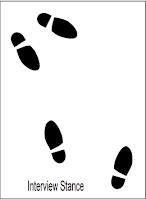“Beware, the LORD is about to take firm hold of you and hurl
you away, O you mighty man.” (Isaiah 22:17)
The purpose of a hold is to control the subject through either restraining
limbs, pain-induced compliance, or both. The most common holds in self-defense are wrist locks [1],
escort holds [2],
and arm bar holds. [3] Leg
locks are a possibility [4],
but advisable only if you end up on the floor.
On the practical side, though, our first reaction to a violent move
will most likely be to block [deflect] a blow, then move on to a hold if that
does not stop the attack. If the other
person is simply having an angry outburst, the attempted hit may relieve their
tension (similar to pounding on a table) with no need to restrain them.
In order to deflect a blow, you must first be ready to respond. In the recommended Interview Stance, [5] the feet are shoulder-width apart
at a slight angle away from the subject. The weak side is closer to the subject, and
the strong foot is back a little. This
gives you more room and time to respond to a move by the subject, and your arm
is better when moving across you than out to the side. If you are the same-handed as the subject, it
gives you the advantage of position.
The hands are held in a relaxed-yet-ready position just above the
waist. You may cup the hands lightly,
but don't clasp them. That way you can
quickly move them independently.
If a blow comes at chest-to-shoulder height, bring the arm on that
side up and out, deflecting the blow out from the inside. Your other hand is ready for a move from the
subject's other hand. If the fist swings
up from below, parry down and out. With
your hands in the middle, you can go either direction.
If the subject starts with a kick, he is committed to a trajectory.
You can move out of the way and may be
able to grab the foot, pulling him off balance.
A wrist lock is the most common hold. It often leads into an escort hold or an arm lock.
The arm lock can become a shoulder lock
or an arm bar. The wrist lock becomes a
hold in itself by rotating or hyper-extending the wrist. This immobilizes the hand and allows the
defender to control the arm. Done to an
extreme, it can tear ligaments and dislocate the wrist, so care is needed to
prevent needless injury.
The escort hold [6],
called a come along by the Marines, allows you to take the subject to
where you want him to go, such as the door, a corner, or a room. In it the defender holds the wrist with one
hand and the upper arm with the other, pushing the subject along from behind
that shoulder.
In an arm bar hold, the arm is held bent at the elbow behind the
subject's back with the hand forced up. This can be a pain-compliance hold by
forcing the arm further up, a procedure commonly called twisting his arm
behind his back. It can be used as an escort hold. Like the wrist lock, this can result in injury
if carried far enough.
Leg locks are on-the-ground holds. In self-defense you do not go to the ground
just to do a leg lock, but if you are on the ground, this is a way to keep the
attacker from controlling you. Depending on the type of leg lock used, hip and
knee injuries can result. This is
especially true for the foot lock which can dislocate a leg bone at the ankle.
Blocks, holds, and locks are not likely to cause death unless they
make a subject's head hit a hard surface or cause him to fall off a height or
into dangerous machinery or traffic. However,
there is the potential of injuries to ligaments, muscles, and joints. There is also danger to yourself if a hold is
not properly executed and a further-enraged attacker gets the upper hand.
By avoiding injury, we avoid charges (civil or criminal) of using
excessive force. To avoid needless
injury to ourselves or the subject, we need to be properly trained in using
holds. This includes practice, not only
in training, but periodically after that. You and other team members can practice using
holds in a safe place (a practice room or gym with mats).
In self-defense, holds and locks are a means of gaining and keeping
control of an attacker. They must be
executed properly to be effective and safe, which requires regular training.
Be safe!
Integrity Security Consulting
Russ Sharrock
405-762-2471 |
integrityseccon@hotmail.com
[1] Wikipedia, "Wrist lock" [https://en.wikipedia.org/wiki/Wristlock].
[2] David Kahn, "The Israeli Krav Maga
("Contact Combat") Glossary: By David Kahn," David Kahn Krav
Maga, no date [https://www.davidkahnkravmaga.com/glossary].
[3] Wikipedia, "Arm lock," [https://en.wikipedia.org/wiki/Armlock].
[4] Wikipedia, "Leg lock," [https://en.wikipedia.org/wiki/Leglock].
[5] Silver Sentinel, "Patrol Tip: The
Interview Stance," Sentinel Handbook, May 11, 2013 [https://sentinelhandbook.wordpress.com/2013/05/11/patrol-tip-the-interview-stance/].
[6] Gregory Knapp, "Come along Holds," Self
Defense Guides, no date [https://www.selfdefenseguides.info/close-combat/comealong-holds.html].





No comments:
Post a Comment